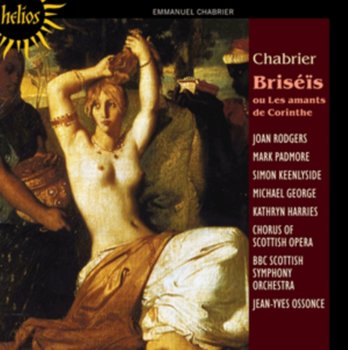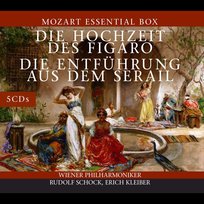
Sprzedaje dvdmax : 57,49 zł
Sprzedaje ABE MEDIA : 87,00 zł
Wszyscy sprzedawcy
Każdy sprzedawca w empik.com jest przedsiębiorcą. Wszystkie obowiązki związane z umową sprzedaży ciążą na sprzedawcy.
Potrzebujesz pomocy w zamówieniu?
ZadzwońMasz już ten produkt? Dodaj go do Biblioteki i podziel się jej zawartością ze znajomymi.
Potrzebujesz pomocy w zamówieniu?
zamknijSprawdź jak złożyć zamówienie krok po kroku.
Możesz też zadzwonić pod numer +48 22 462 72 50 nasi konsultanci pomogą Ci złożyć zamówienie.
Może Cię zainteresować
Chabrier’s extraordinary, if incomplete, opera is surely a precursor to Salome and approaches even that most lurid work in the gloriously opulent sensuality of its music. Performed at the Edinburgh Festival by some of the greatest singers of the day and recorded live by Hyperion, this thrilling performance stunned critics and public alike. A genuinely wonderful discovery.
Goethe referred to his ballad Die Braut von Korinth (‘The Bride of Corinth’) as his ‘vampire poem’. It is true that there is a macabre element in it strong enough to have upset some of the more seriously inclined of the poet’s contemporaries, who felt that a great mind like his ought to have been devoted to higher things. But there are higher things in it too, the most interesting of which, from an operatic point of view, is the rudimentary Liebestod at the end: to be united at last in the marriage denied them in life, the blood-sucking bride and her bridegroom victim are consigned at her command to the flames of the funeral pyre. Their fate—in a Corinth split between converts to the new Christian religion of self-denial and adherents of the pleasure-loving gods still in place on Olympus—symbolizes to a bizarre extreme the rift in civilization as one faith declines and is replaced by another.
In the hundred years between the publication of Die Braut von Korinth and the first (posthumous) performance of the one complete act of Chabrier’s Briséïs, Goethe’s ballad had become a minor cult with French writers and composers. Camille du Locle had adapted it as the libretto for Duprato’s La fiancée de Corinthe, which was produced at the Paris Opéra in 1867; Anatole France had written a verse drama Les noces corinthiennes, a frank celebration of paganism, in 1876 (Henri Büsser made an opera of it forty-six years later); and Ephraïm Mikhaël had collaborated with his symbolist colleague Bernard Lazare on a ‘dramatic legend’ in three acts, La fiancée de Corinthe, which appeared in Paris in 1888.
By the time Chabrier got to work on the story the Liebestod element had become the principal and culminating feature. The vampire had disappeared, to be replaced by a bride who returns from the dead to claim her long-promised husband, as in Goethe’s ballad but now with no predatory intent. Both these developments had been made in Mikhaël and Lazare’s La fiancée de Corinthe which, though the structure was to be reshaped and the names of the characters changed, is clearly the basis of Briséïs. A significant refinement in the opera—introduced, presumably, by Catulle Mendès—is that the Christian-convert mother condemns her pagan daughter to a life of chastity as a bride of Christ not merely to save her own skin but so that she might continue to pursue her missionary work among the unconverted Greeks. Most important of all, the lovers’ union in death at the end of Briséïs inspires a reconciliation between the conflicting elements of Christianity and paganism.
The background to the three-way collaboration between Mikhaël, Mendès and Chabrier is obscure but it is not difficult to work out what must have happened. It is surely not coincidental, for example, that Chabrier’s first recorded reference to the Briséïs project was made in 1888, the year in which Mikhaël and Lazare’s La fiancée de Corinthe was published in Paris—with a dedication to none other than Catulle Mendès. The likelihood is that Mendès saw the operatic potential in the ‘dramatic legend’, proposed to Mikhaël that they should collaborate in creating a libretto on the same subject, and suggested the idea to Chabrier. Certainly, it was in April 1888 that the composer wrote to Ernest Van Dyck (the Belgian tenor whom Chabrier had coached for the first Paris performance of Lohengrin in 1887 and who was now much in demand for Wagnerian roles in Germany) to tell him that although ‘I don’t yet have the libretto of my dreams, we are working on it and—big secret, keep quiet about it, you alone know this—it will be by Catulle Mendès, who is the only man capable of setting up a real lyric drama.’
If Chabrier over-estimated Mendès’s literary abilities he was not alone among his contemporaries in doing so. Debussy was to see through the fashionable reputation to the (as Dukas later described it) ‘Parnassian bric-à-brac’ underneath when he abandoned his ill-advised collaboration with Mendès on Rodrigue et Chimène in 1892. But Chabrier was quite happy with the ‘very beautiful verse’ Mendès had written for Gwendoline, their first operatic project, and he was confident that Briséïs—which he described as ‘a paraphrase in three acts and four tableaux of Goethe’s ballad The Bride of Corinth’—would be ‘tender, poignant, super-passionate’.
Declaring that his score would be the last word in modernism, Chabrier confessed that he did not know if it would be French but he was sure it would not be Wagnerian. ‘I try to inoculate myself with the aesthetic of the man of bronze’, he said, ‘but never with his music.’ In fact his music is harmonically ten years ahead of its time and is very French except where it is too plainly reminiscent of Wagner, which is mainly in the more dramatically significant modulations and in the shape of some of the leitmotifs.
In August 1888 Chabrier reckoned that it would take him sixteen months to get to the end of Briséïs. Six years and one month later he died having completed the first act and leaving no more than a few variably decipherable sketches for later episodes in the opera.
There are many reasons for Chabrier’s failure to achieve what he regarded as the climax of his life’s work. There were early delays caused by Mikhaël’s apparent unwillingness to get on with it, which the composer found intolerably irritating (although, had he known that the unfortunate poet was to die at an early stage in their collaboration, at the age of twenty-four, he would obviously have been more understanding). Chabrier had money worries at this period too: so, although he was a hopeless teacher, he had to give lessons and devote time to writing music which he could readily sell—hence the composition of some of his most delightful mélodies, including a setting of Mikhaël’s L’île heureuse and the farmyard songs to words by Edmond Rostand and Rosemonde Gérard. He had to keep travelling to Germany where, thanks largely to the efforts of Felix Mottl, his operas were far more in demand than they were in France. His wife’s already delicate health was deteriorating. Most distressing of all, his old nurse, Nanine, of whom he was inordinately fond and who had lived with him all his life, died in 1891, leaving him unable to work for months on end.
He could probably have coped with all that but for the basic problem that, at the same time as he was making a supreme effort to expand his creative resources, his final illness was inexorably contracting them. On a visit to Bayreuth in 1889 he had seen Parsifal for the first time and (with Van Dyck ‘quite extraordinary’ in the title role) found it overwhelming: ‘One comes out after each act absolutely overcome with admiration, bewildered, distraught, with tears running down one’s cheeks.’ If he did not at first have Parsifal-esque ambitions for Briséïs he certainly had by now. But, as he forced himself to work on a structural and moral scale he had never previously envisaged, the paralysis associated with the terminal stage of syphilis was advancing on him.
Even as he finished the first act Chabrier seemed to sense that he would not get much further: ‘Mottl could perform the first act, which I finished orchestrating the day before yesterday’, he wrote to Van Dyck in Germany on 29 September 1890. ‘I have worked my guts out’, he added inelegantly but ominously. He played what there was of the work to his friends in Paris and left for his country retreat at La Membrolle in Touraine ‘to hide himself away like a sick animal’.
It was not until the end of March 1894—after a period of years spent mainly at La Membrolle where he could scarcely bear to let the score of his ‘dear Briséïs’ out of his sight—that he finally gave up and got Vincent d’Indy, the best-equipped among his composer friends, to undertake to finish the work for him. When eventually called upon to do the job, however, d’Indy, for all his good intentions, had to extricate himself from his promise. He was dismayed to find that what he had been led to believe would be just a matter of orchestration would really be a labour of composition from a few fragmentary sketches; and, anyway, he could not possibly work with Mendès’s libretto.
Chabrier’s heirs had no more luck with Antoine Mariotte, Alfred Bruneau, Claude Debussy, Georges Enescu or Maurice Ravel, all of whom were invited to complete the work at one time or another. But, as the composer himself was aware and as d’Indy so wisely pointed out, ‘what there is of Briséïs can be perfectly well played and sung in concert and will be very interesting in that form’. The first act was, in fact, introduced to the world by Charles Lamoureux at a Chabrier memorial concert in Paris on 31 January 1897. The first staged performance took place in Berlin in January 1899 under the direction of none other than Richard Strauss (who seems to have remembered something of the work when he came to write his Salome) and the first Paris Opéra production opened four months later.
Scene one
In spite of his large-scale structural ambitions in Briséïs, Chabrier still preferred to construct his scenes as a succession of separable (if not exactly separate) numbers. While rejecting Wagnerian ‘declamation’, which he considered very boring, he insisted nonetheless on threading a Wagnerian network of leitmotifs through his orchestral textures. As he confessed, it was ‘a long and meticulous job’ involving the ‘twisting and torturing’ of themes which he was determined not to present in a string of literal repetitions.
Whatever the problems, Chabrier’s motivation rarely seems anything but spontaneous. There is an appealing freshness, for example, in the rising and falling sixths of the serene sailors’ song at the beginning, and the ‘Briseis’ motif—introduced by the strings at the point where Hylas first mentions her name and then repeated in all kinds of variants before her first appearance—is as graceful as it is brief. The painful message of the harmonies associated with Briseis’s first mention of her sick mother is clear from the first tritone. On the other hand, which god it is—Olympian or Christian—who has given Thanasto temporary relief from her illness and who is briefly represented by a firmly diatonic melody in the orchestra, is not made clear at this point. Hylas’s invocation of Eros, the intervals of his vocal line gradually expanding over an ostinato of bounding octaves, is an extraordinary expression of pagan energy.
Scene two
One of the more Wagnerian of Chabrier’s motifs is the one which, striding up from the bass in fifths and fourths, accompanies the vows of Hylas and Briseis as they swear by ‘l’auguste Kypris’ (or Aphrodite) to love each other until their very last days. More characteristic of Chabrier, and even more significant dramatically, is the legato three-note descending phrase associated with Briseis’s apparently eccentric but actually ominous insistence that love must survive beyond death and into the tomb. Echoes of the lovers’ joyous anticipation of their wedding day—Briseis singing from the shore, Hylas from the ship—are combined with a varied repeat of the sailors’ song as they set sail again. Several of the foregoing themes are reviewed in the orchestral interlude accompanying Briseis’s reflections as she is left alone at the end of the scene.
Scene three
The suffering tritones reappear at the beginning of the third scene, both in the orchestra and in the choral exclamations of ‘Hélas!’. One or two other painful motifs associated with Thanasto contrast most effectively with the tenderness of the melody symbolizing the daughter’s love for her mother as Briseis first addresses Thanasto in ‘Mère, qui me portais …’ But the most memorable melody of the scene—and potentially one of the main themes of the opera—is the triumphant march tune which, in her missionary zeal, Thanasto twice sings to the words ‘Pour qu’au jour des moissons superbes’. If the presence here of a clear echo of the Chanson de l’alouette from Le roi malgré lui is frustratingly puzzling, the significance of a new vow motif in descending minor thirds, introduced as Briseis promises to give her life to save her mother, is all too clear.
Scene four
The last scene—Chabrier’s supreme creative effort—begins with an orchestral development and choral apotheosis of a simple diatonic theme briefly anticipated earlier and associated now with Apollo. The Catechist enters with his own motif in a fanfare of trumpets and prays for Thanasto in Gregorian chant. But far from insisting on the difference between them, Chabrier combines the Christian and Apollonian themes in a grandly ecumenical orchestral gesture. So the way is prepared for the eventual reconciliation between faith in the Olympian gods, now invoked with crown-imperial harmonies by Stratocles, and the radiant Christian message of the Catechist. There is no prospect of reconciliation of the dilemma facing Briseis, however. After a conflict between the motifs representing the two vows, her own to Hylas and her mother’s to God, she is compelled to comply with the latter and is banished to a life of chastity, accompanied by the melody representing her love for her mother and the latter’s triumphant march theme.
In his pleasingly affectionate but often misleading little book on Chabrier, Francis Poulenc gives a brief (and inaccurate) description of the events so far and adds, ‘I do not know what would have happened in the following acts’. But it is all there in the libretto, which was published complete (with the vocal score of the first act) in 1897. Once she has made the Christian vows necessary to save her mother, Briseis kills herself and then calls upon Hylas to join her in the nuptial grave—which, after breathing in the deadly scent of the flowers she offers him—he joyously does, to the wonderment of Christians and pagans alike.
This recording is of a concert performance given in Usher Hall during the 1994 Edinburgh Festival—the first performance ever in Britain, and the first for a long time anywhere.
| ID produktu: | 1052483274 |
| Tytuł: | Chabrier: Briseis ou Les amants de Corinthe |
| Seria: | Helios |
| Wykonawca: | Rodgers Joan , Padmore Mark |
| Dyrygent: | Ossonce Jean Yves |
| Orkiestra: | BBC Scottish Symphony Orchestra |
| Dystrybutor: | Music Island |
| Data premiery: | 2012-07-01 |
| Rok nagrania: | 1994 |
| Producent: | Hyperion |
| Nośnik: |
CD
 |
| Liczba nośników: | 1 |
| Wymiary w opakowaniu [mm]: | 125 x 10 x 142 |
| Indeks: | 11717058 |


































ocen
Podziel się na Facebooku
Właśnie zrecenzowałem Chabrier: Briseis ou Les amants de Corinthe
Chabrier’s extraordinary, if incomplete, opera is surely a precursor to Salome and approaches even that most lurid work in the gloriously opulent sensuality of its music. Performed at the Edinburgh ...